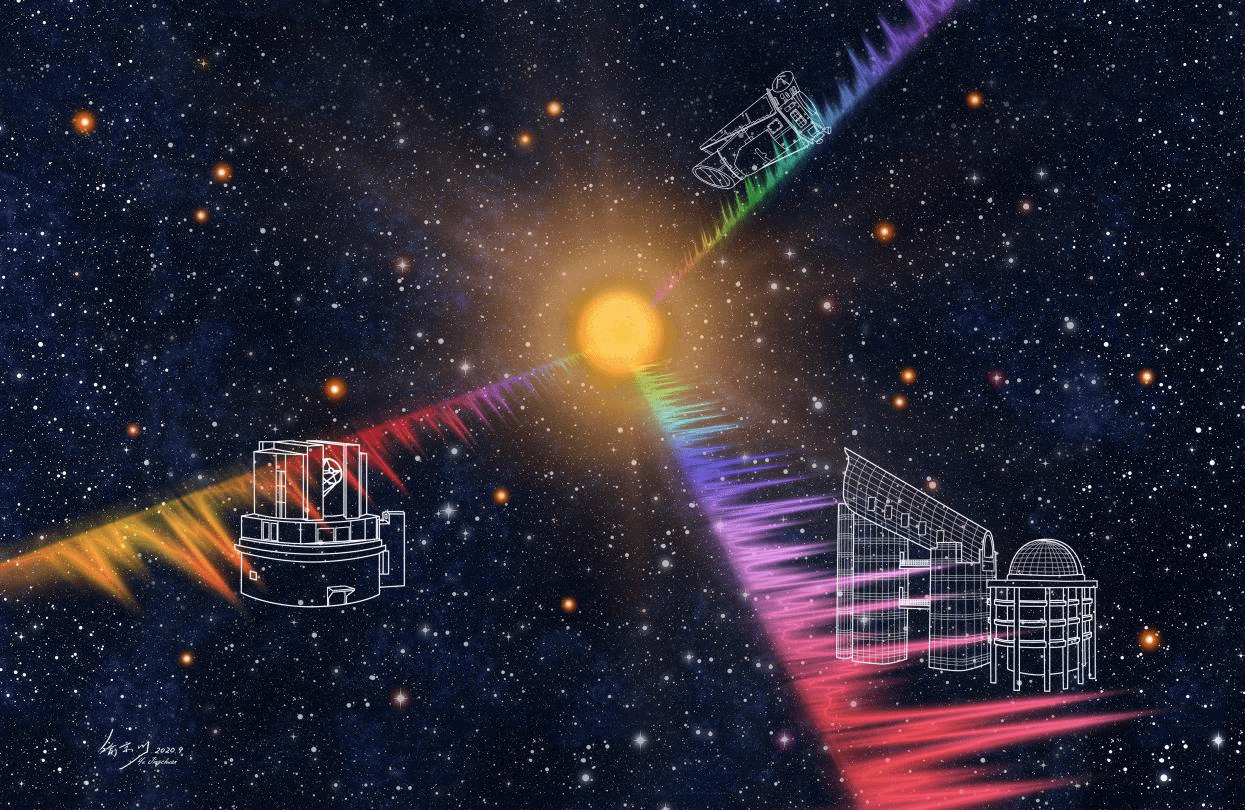Lithium is one of the light elements produced at the early universe. As one of the building blocks of our present-day universe, the lithium we observed in many celestial bodies contradicts the prediction of classic theories. Lithium-rich stars, accounting for only 1% of the total number of the low-mass evolved stars, is one example of such conflict. They exhibit thousands of times more lithium than the normal stars that account for the rest 99%. Astronomers are wondering what these stars really are and why their lithium beyond our expectation so much.

Fig1. Astronomers reveal the secrets of the lithium-rich low-mass evolved stars by astroseismology and analyzing their spectra.(CREDIT: YU Jingchuan, Beijing Planetarium)
A recent study revealed the actual evolutionary stage of lithium-rich stars by the Chinese astronomers is published in the Nature Astronomy on Oct.5. Yutao Zhou, the LAMOST Fellow from the department of astronomy at PKU, is involved in this study as the co-first author. By combining the LAMOST spectra with the asteroseismic data from Kepler, they find that most lithium-rich stars are located at the evolutionary stage of red clump instead of the red giant branch as previously thought. The findings challenge the previous theories of lithium enrichment, which is vital to resolve the problem of lithium origin.

Fig2. The internal structure of red clump stars is different from red giants with hydrogen nuclear burning around the central core, but the temperature and luminosity of clump stars are indistinguishable from some red giants(CREDIT: Wako Aoki, National Astronomical Observatory of Japan)
As the human being, the star will be born, grow, age and die. The Sun is in its middle age. When the star continue to glow and burn, various changes will follow with the change of internal nuclear reaction. Low-mass stars will evolve off the main sequence at the end of their core hydrogen burning phase: during the red giant branch (RGB) ascent, the star has an inert helium core surrounded by a hydrogen burning shell. After a few million years, the red giant star will go through the helium flash to become the red clump star with a core helium burning. The red giant branch and the red clump are the different stages after the main sequence, their internal structure and physical process are significantly different because of the distinctive nuclear reactions in the their interiors. However, the red giant star looks like the red clump star with some “similar appearances”, it is really hard to tell which stage the star is by the external characteristics or the H-R diagram, just as it is difficult to say who is older between two gray-haired elders by their appearances only. Previous studies suggested that as the convection velocity in the star will gradually increase as the star evolves toward the red giant, the environment of rapid convection in the red giant star is good for producing lithium. However, the red giant star might be reasonably mistaken for the older red clump star by the external characteristics, the theroies of lithium production in the red giant star could not explain the lithium rich red clump star.
The research team obtained a quite distinct result with the help of the oscillated information monitored by Kepler and the stellar spectra from LAMOST, Subaru, APO 3.5m, Lijiang 1.8m and 2.4m. The information of internal structure of star is transmitted out by an earthquake-like oscillation. The red giant star and the red clump star can be easily distinguished by the asteroseismology though they look alike on the chracteristics of luminosity and effective temperature, because their internal oscillation modes are not the same. If we imagine the oscillation of star as the heartbeat of human, the “heart rate” of red giant star will faster than the older red clump star’s. The research shows that over 80% of lithium-rich stars are the red clump stars. Moreover, the lithium-rich stars at these two stages present different distributions in the lithium abundance, the distribution of lithium-rich red giant stars declines steeply with increasing lithium abundance, with an upper limit of around 2.6 dex, whereas the lithium abundances of red clump stars extend to much higher values.
The lihitum rich in the red clump star is hard to be explained by the current scenarios. The lithium-rich scenarios of red giant star should not be appropriated for the red clump star due to the different internal structures. A few theories were proposed to account for this issue, including helium flash, binary-merger, extra-mixing, etc. In this research, they suggests that the binary-merger is a potential scenario by verifying its predictions with the observational results. To check the other theories is a further step to the truth of lithium-rich secret.
The research is done by an international team with scientists from institutes worldwide, including China, Japan, France, Netherlands, United States, Australia, and Denmark. The involved Chinese institutes include National Astronomical Observatories of CAS, Peking University, Beijing Normal University and Yunnan Observatories. Besides LAMOST, Subaru, and Kepler, four other telescopes contributed the data, including the 3.5-meter telescope at Apache Point Observatory, the Automated Planet Finder telescope at Lick Observatory, the 2.4-meter and 1.8-meter telescope at Lijiang Observatory.
Publication link: https://www.nature.com/articles/s41550-020-01217-8